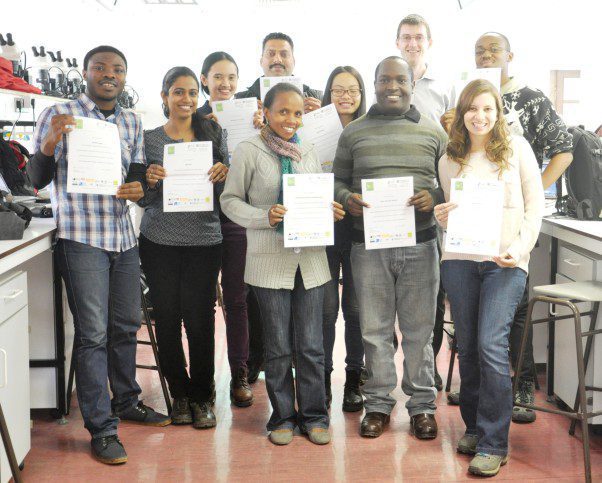by Lalao Aigrette, Senior Blue Carbon Scientist, Toliara – Madagascar
The purpose of my first ever visit to Europe was to attend the fifteenth Student Conference on Conservation Science (SCCS) in Cambridge, UK from March 25th to April 2nd. The SCCS was organised jointly by the Tropical Biology Association (TBA) and the University of Cambridge. To get to Cambridge, I flew for 15 hours and spent the night on a plane. More than two hundred students from approximately 60 different countries were invited to attend the conference and there were five delegates from Madagascar, including one who is currently studying at the University of Cambridge and is none other my old colleague Mialy!
Posters and oral presentations took place throughout the conference. Since the Blue Forests team have recently published the first total carbon stock assessment of Madagascar’s mangroves (Jones et al. 2014). I presented these findings in an oral presentation. The take home message from my talk was that mangrove forests are amongst the most carbon dense in the world; the bulk of the carbon in mangrove forests is in found in the soils and is very high compared to terrestrial counterparts, such us boreal, temperate and tropical. Due to the mangrove roots adaptation, they are able to trap sediments and litter from upstream which break down very slowly because there is not enough oxygen to break it down.
Following the three full days of conference, a short course on the use of camera traps and Geographic Information Systems (GIS) was given to students who received bursaries. Although I have very little knowledge on these two subjects, this short course provided me with a great opportunity to learn how helpful camera traps and GIS are for data collection and processing. For the GIS training, we were using the Quantum GIS software; I am now able to manipulate a map using GIS but thankfully, within Blue Ventures we have several team members with many years of geospatial experience and who are whizzes at GIS.

I am not a ornithologist, or even a bird watcher, but the excursion to the Royal Society for the Protection of Birds‘ (RSPB) reserve, Lakenheath Fen, converted me to be a bird fan. In my country ducks and the geese are eaten for special meals during special public holidays (for e.g. new years, Independence Day, etc.) or big events, so I was very surprised that these are protected at the RSPB site. I couldn’t help but wonder how tasty they would be in a Malagasy dish! I was also very impressed with the RSPB approach in “re-wilding”, aiming to give nature a home in previously developed or cultivated areas, – many of their reserve sites have been re-wilded. Madagascar has several wetlands but few of them are protected. I was thinking that the RSPB approach is good example for protecting wetlands ecosystem and should copied in Madagascar!
Travelling back home was also a bit of an adventure! I almost missed my connecting flight in Mauritius due to technical problems with the plane! My flight from London to Paris was delayed by 40 minutes and I had very little time for my connection from Paris to Mauritius and still needed to check in. At this time, I wish I could have used some of my seven hour layover in Mauritius for this part! During my layover in Mauritius, I had another interesting experience. My name was called over the PA system, inviting me to take a look at my suitcase which it turned out had broken and almost fallen apart. Fortunately none of my belongings were lost and the Air Mauritius staff transferred them into a large plastic bag for the final leg to Madagascar. I borrowed this suitcase from a friend in Cambridge for my extra luggage, which was comprised entirely of “voandalana” (presents) for family and friends in Madagascar. My friends and family were as relieved as I was that none of the presents were lost!

